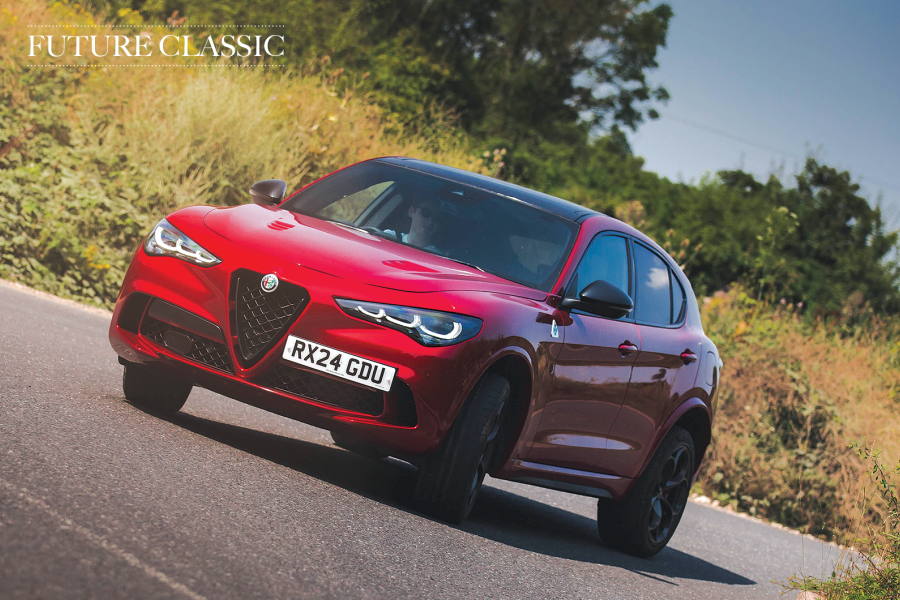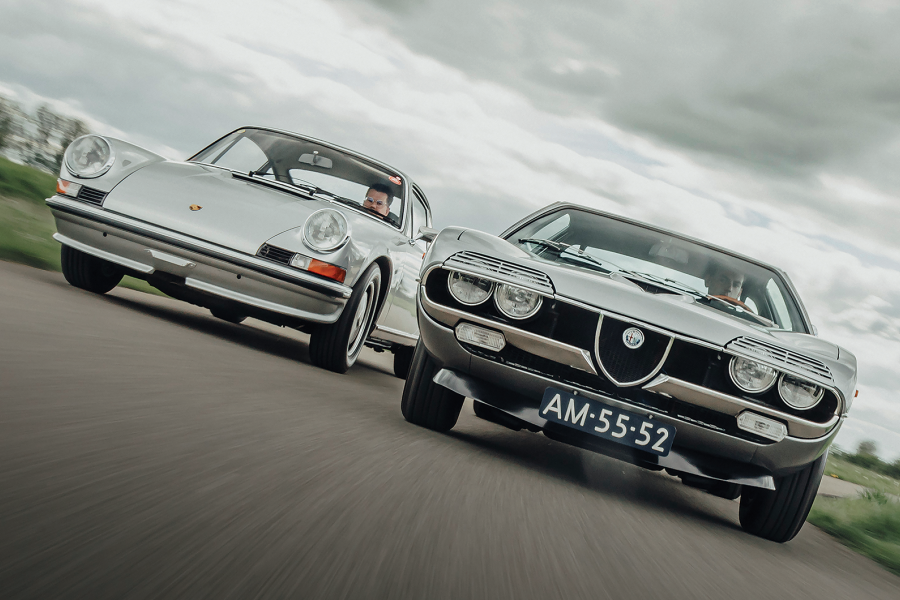After the confines of the Lotus, the Porsche feels very generously proportioned, almost saloon car roomy – particularly in terms of width (it’s the widest here).
It’s comfortable, too, with cossetting seats, but stepping from the Elite the German doesn’t feel anything like as quick or focused.
It doesn’t hang around, though, and if you give it plenty of revs before shifting up (with a typically VW, long-throw gearchange) it will bowl along very nicely indeed.
Despite any misgivings about a rear engine and swing axles, I can find nothing intimidating about its handling balance – in the dry, at least.
The Alfa just edges the Porsche on performance
It also has an effortless ability that’s missing from the Lotus when it comes to undertaking long journeys.
I’ve travelled hundreds of miles in 356s, and can testify that they are supremely relaxing over such distances.
The layout means that there is little mechanical noise at speed, while the suspension works with admirable ability – albeit with that familiar bobbing around the nose.
At ten-tenths, the Lotus may be the quicker, but to paraphrase a slogan used by Porsche’s UK concessionaire in period, the 356 feels like the most effortless fast car in the world.
The Porsche 356B has a roomy and comfy interior
The Alfa, like the Porsche, is a surprisingly relaxing place to be.
From the outside it looks by far the biggest of our quartet (that’s largely an optical illusion), but once ensconced you struggle to assimilate just how much room is on offer.
You could almost squeeze a family of four inside, although the Giulietta was marketed in the UK as a two-seater (in left-hand-drive): a set of cushions to make the parcel shelf into occasional seating was a £12 optional extra.
Up front, you sit on chairs bolted flat to the floor, legs outstretched towards the floor-hinged pedals and grasping a huge two-spoke wheel.
In the Giulietta Sprint, note the angle of the gearlever
The cabin is supremely stylish and, of the four, provides the greatest sense of occasion – as well as some intriguing details.
Mysterious knobs on the fascia include one marked with what appears to be an exploding box, while another shows a flame emitting radio waves.
The car is, of course, a cut-down saloon rather than a purpose-built coupé, but it’s still a rewarding machine to punt along.
The long gearstick leaning back at a good 45º may not look too purposeful, but it is a joy to use – by far the nicest here – and even has five ratios.
Steel MGA or glassfibre Lotus Elite?
Although you can keenly stir the Giulietta along, it encourages a more laid-back style.
Above all, the Alfa feels grown up; it can live with its rivals and the drum brakes offer admirable retardation, but it feels somehow more suited to a gentler pace.
As with the Lotus, the cabin of the MG is definitely on the cosy side. The ambience is far more traditional, too, with its black Rexine dash, no-nonsense white-on-black instruments and shallow, upright windscreen.
The Bluemels wheel is mounted very much in the vintage idiom, enhancing the old-school flavour, but when you fire up that much-maligned engine, it’s not at all what you’re expecting.
You’ll find a sprung wheel inside the traditional MGA
Where BMC’s pushrod units were charming but unsophisticated sloggers, this is a jewel.
As the speed builds around our test track, the MG really starts to come into its own – even considering the lower-compression engine that has been fitted to the featured example in the name of reliability.
If the Alfa feels a touch lazy in this rarefied company, the MG is seriously fast and handles beautifully. As I embark upon lap after lap, I become increasingly ensnared by this magnificent little car.
It is the most inspiring thing that I’ve driven in a long time, which makes it all the more frustrating that its reliability problems were addressed too late to save it.
The MGA’s tiny boot necessitates a luggage rack
If the engine had been properly sorted before it had gone on sale, it would surely have sold in significant numbers, and who knows what else it could have led to?
It’s not perfect, of course. Besides being a bit tight on space, it gets awfully hot inside and it’s not exactly quiet.
There really isn’t much puff at low revs, either, but wind the rev counter around towards the red paint and the MG starts to come alive, goading you to push ever faster before double-declutching down through the slightly notchy ’box as the four-wheel discs rein you in for the next corner.
The Lotus could probably run rings around it, but I don’t care.
All four have a lot to offer
All four are brilliantly tempting, and if I had the wherewithal I’d gladly take any of them home.
To single out a winner is an extremely tough call but, although I’m most naturally drawn to the Alfa and Porsche, I struggle to shake off the addictive charm of the MG.
Images: Tony Baker
Thanks to Edward Vandyke; Southwood for the Alfa; Richard Norris; Percival for the Lotus; GE Classic Cars for the Porsche
Factfiles
Alfa Romeo Giulietta Sprint
- Sold/no built 1954-’62/24,084 (Sprint and Sprint Veloce)
- Construction steel monocoque
- Engine all-alloy, double-overhead-cam 1290cc inline ‘four’, twin Weber carburettors
- Max power 90bhp @ 6500rpm
- Max torque 87lb ft @ 5300rpm
- Transmission five-speed manual, driving rear wheels
- Suspension: front wishbones, anti-roll bar rear live axle, trailing arms, central A-arm; coil springs, telescopic dampers f/r
- Steering worm and roller
- Brakes drums
- Length 13ft 2in (4013mm)
- Width 5ft ½in (1536mm)
- Height 4ft 4in (1321mm)
- Wheelbase 7ft 9½in (2374mm)
- Weight 2142lb (972kg)
- 0-60mph 13.2 secs (1600)
- Top speed 112mph (1600)
- Mpg 28
- Price new £2480 (1960)
MGA Twin-Cam
- Sold/no built 1958-’60/2111
- Construction steel box-section chassis, steel body
- Engine iron-block, alloy-head dohc 1588cc inline ‘four’, twin 1¾in SU carburettors
- Max power 108bhp @ 6700rpm
- Max torque 104lb ft @ 4500rpm
- Transmission four-speed manual, driving rear wheels
- Suspension: front double wishbones, coil springs rear live axle, semi-elliptic springs; lever arm dampers f/r
- Steering rack and pinion
- Brakes discs
- Length 13ft (3962mm)
- Width 4ft 10in (1473mm)
- Height 4ft 2in (1270mm)
- Wheelbase 7ft 10in (2388mm)
- Weight 2128lb (967kg)
- 0-60mph 9.1 secs
- Top speed 114mph
- Mpg 22
- Price new £1196 (1960)
Lotus Elite
- Sold/no built 1959-’63/988
- Construction glassfibre monocoque
- Engine all-alloy, sohc 1216cc inline ‘four’, twin Weber carbs
- Max power 83bhp @ 6250rpm
- Max torque 75lb ft @ 4750rpm
- Transmission four-speed manual, driving rear wheels
- Suspension independent, at front by coil springs, wishbones rear Chapman struts; telescopic dampers f/r
- Steering rack and pinion
- Brakes discs (inboard at rear)
- Length 12ft 4in (3759mm)
- Width 4ft 10½in (1486mm)
- Height 3ft 10in (1194mm)
- Wheelbase 7ft 4in (2240mm)
- Weight 1450lb (656kg)
- 0-60mph 11 secs
- Top speed 118mph
- Mpg 35
- Price new £1949 (1960)
Porsche 356B
- Sold/no built 1959-’63/30,963
- Construction pressed-steel platform with steel panels
- Engine all-alloy, air-cooled, overhead-valve, 1582cc flat-four, twin Solex, Zenith or Weber carburettors
- Max power 70bhp @ 4500rpm
- Max torque 82lb ft @ 2800rpm
- Transmission four-speed manual, driving rear wheels
- Suspension independent, at front by trailing arms rear swing axles; torsion bars, telescopic dampers f/r
- Steering worm and roller
- Brakes drums
- Length 12ft 11in (3937mm)
- Width 5ft 5½in (1663mm)
- Height 4ft 3½in (1302mm)
- Wheelbase 6ft 11in (2108mm)
- Weight 1883lb (854kg)
- 0-60mph 14.1 secs
- Top speed 103mph
- Mpg 32
- Price new £2050 (1960)
READ MORE
Buyer’s guide: MGA
Sun seekers: Mercedes-Benz 190SL, Porsche 356 and Borgward Isabella
An Alfa Romeo Giulietta Sprint like no other
A cut above: Alfa GT Junior vs Fiat 124 Sport vs Lancia Fulvia Coupé
Malcolm Thorne
Malcolm Thorne is a contributor to – and former Deputy Editor of – Classic & Sports Car




































